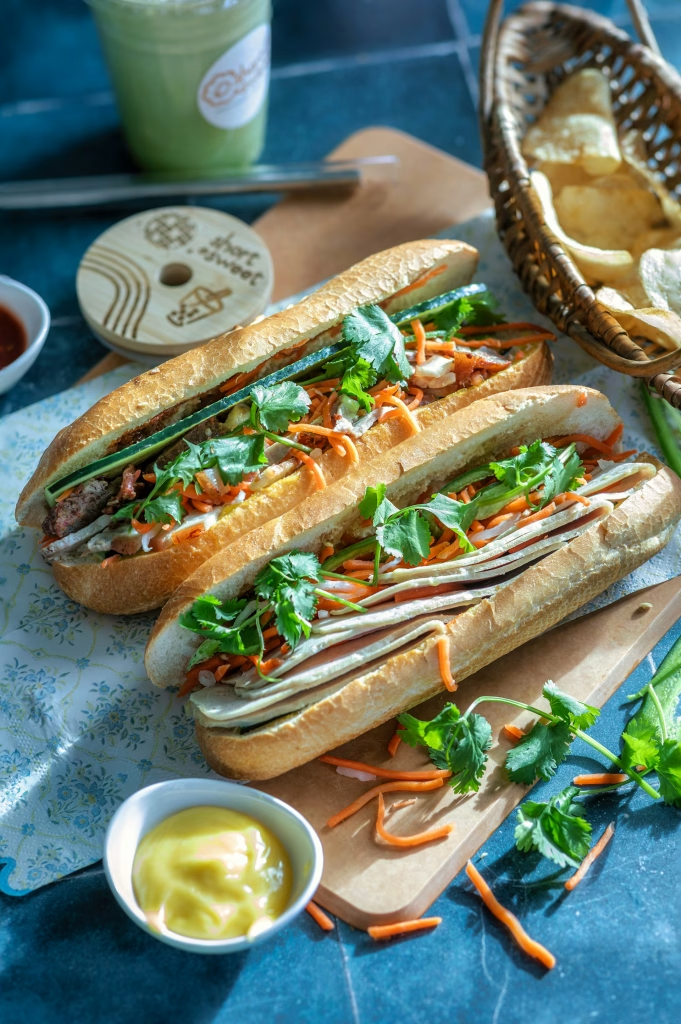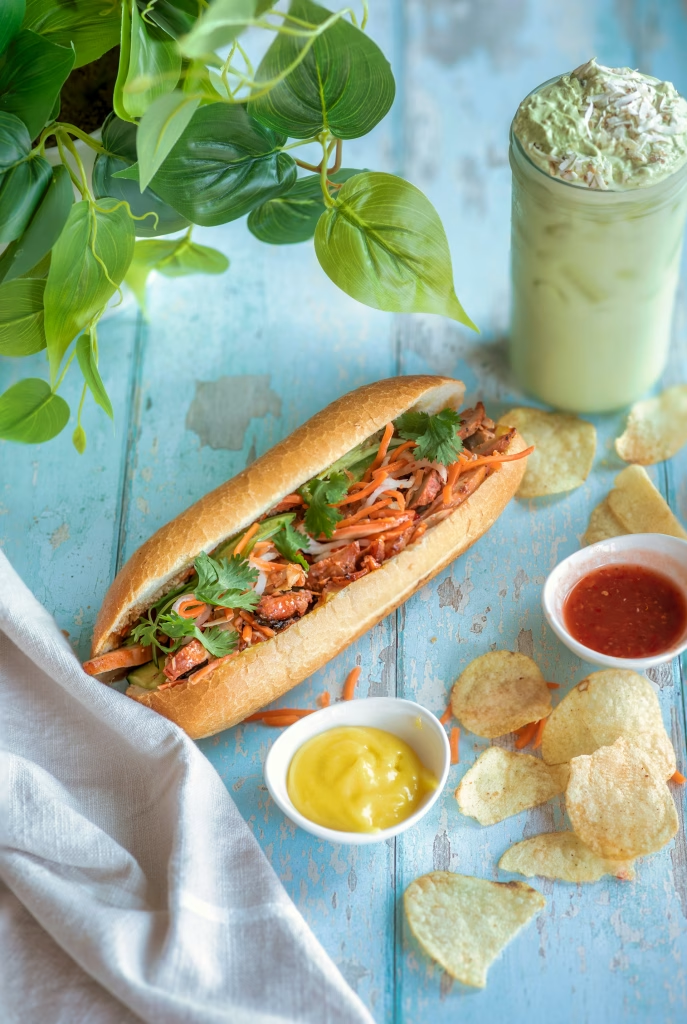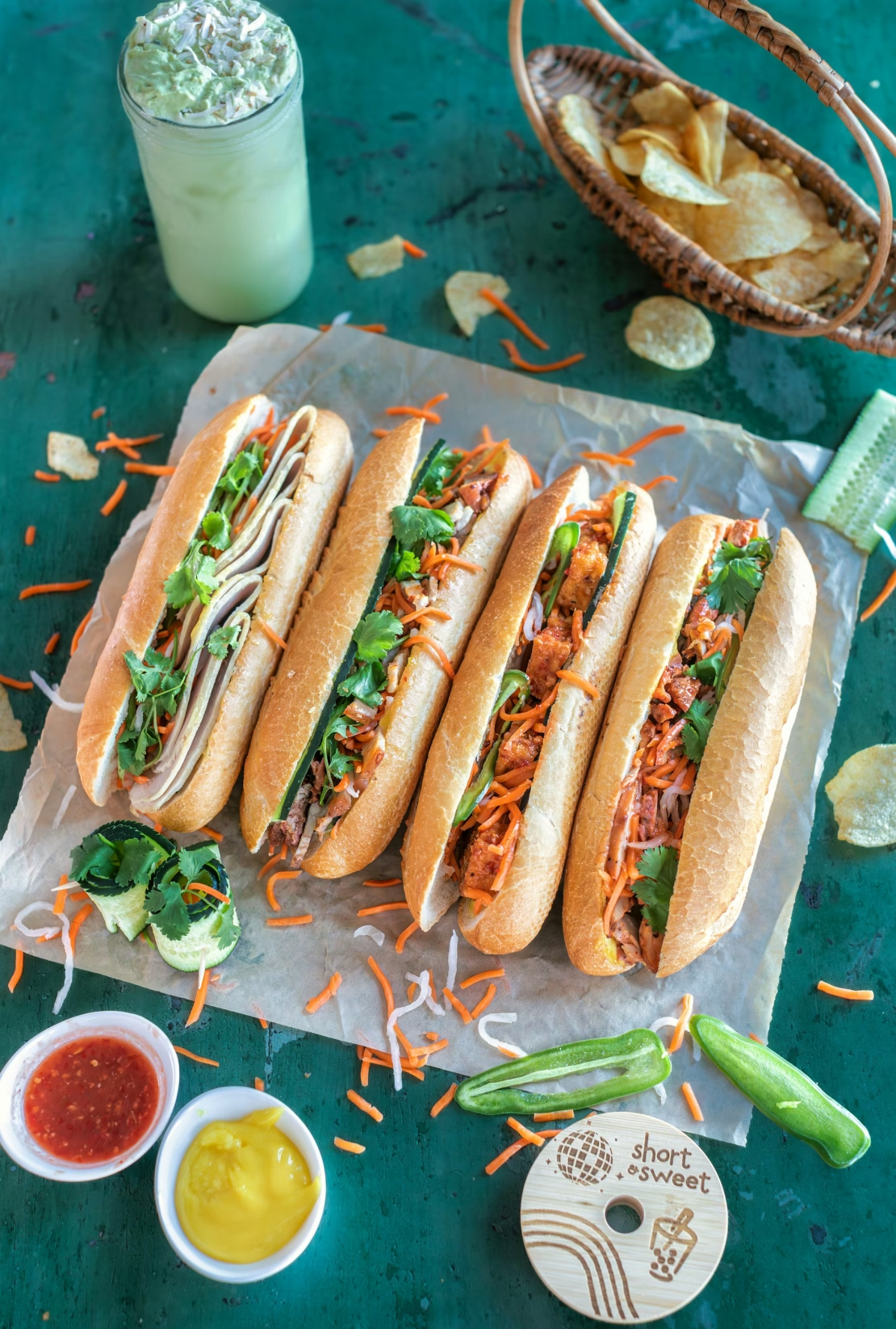Banh Mi with Pork is Vietnam’s most iconic sandwich, blending French culinary influence with bold Southeast Asian flavors.
This handheld delight consists of a crisp and airy French-style baguette, richly marinated pork (often grilled or roasted), and an array of pickled vegetables, fresh herbs, spicy chili, and creamy condiments. From street food stalls in Saigon to gourmet food trucks across the world, Banh Mi has taken its rightful place among the world’s greatest sandwiches. Every bite offers a satisfying contrast of hot and cold, crunchy and soft, sweet and savory—truly a taste of Vietnam in sandwich form.
Table of Contents
Ingredients
For the Pork Marinade:
- 500g (1.1 lbs) pork shoulder or pork belly, thinly sliced
- 2 tbsp soy sauce
- 1 tbsp fish sauce
- 1 tbsp oyster sauce
- 1 tbsp brown sugar
- 2 garlic cloves, minced
- 1 shallot, minced
- 1 tsp sesame oil
- ½ tsp freshly ground black pepper
- 1 tbsp lemongrass (white part only), finely minced (optional but recommended)
For the Pickled Vegetables:
- 1 cup shredded carrots
- 1 cup julienned daikon radish
- 1 tbsp salt
- ½ cup rice vinegar
- ½ cup warm water
- 3 tbsp sugar
For the Sandwich:
- 4 Vietnamese-style baguettes or light French baguettes
- ½ cup mayonnaise (preferably Japanese-style or homemade)
- 1 tbsp soy sauce or Maggi seasoning
- Fresh cilantro sprigs
- Thinly sliced cucumber
- Thinly sliced jalapeño or red chili (optional)
- Optional: sliced pork pâté or ham for extra richness
Serves
Serves: 4 sandwiches
Prep Time: 30 minutes (plus 1 hour marinating or overnight)
Cooking Time: 15 minutes
Pickling Time: 1 hour minimum
Total Time: ~2 hours
Step-by-Step Instructions
Step 1: Prepare the Pickled Vegetables
- In a mixing bowl, toss the julienned carrots and daikon with salt. Let sit for 10 minutes to draw out moisture.
- Rinse and squeeze excess water from vegetables.
- In another bowl, mix rice vinegar, warm water, and sugar until dissolved.
- Add the carrots and daikon. Let them pickle for at least 1 hour (or overnight in the fridge).
Step 2: Marinate the Pork
- In a bowl, mix all marinade ingredients: soy sauce, fish sauce, oyster sauce, brown sugar, garlic, shallot, sesame oil, black pepper, and lemongrass.
- Add thinly sliced pork and coat well.
- Cover and refrigerate for at least 1 hour or preferably overnight for deeper flavor.
Step 3: Cook the Pork
- Heat a grill pan or skillet over medium-high heat.
- Cook marinated pork in batches for 2–3 minutes on each side until caramelized and slightly charred.
- Set aside and keep warm.
Step 4: Assemble the Banh Mi
- Slice the baguettes lengthwise, leaving a hinge.
- Toast lightly if desired for extra crunch.
- Spread mayonnaise on both inner sides.
- Layer with grilled pork, then add cucumber slices, pickled carrots and daikon, fresh cilantro, and sliced chili.
- Drizzle a little soy sauce or Maggi seasoning for umami.

Serving Suggestions
- Side Options: Serve with iced jasmine tea or Vietnamese iced coffee (ca phe sua da).
- Make it a Meal: Pair with spring rolls or a light pho broth.
- Street-Style: Wrap in parchment and enjoy on-the-go.
- Banh Mi Platter: Serve components separately and let guests build their own sandwiches.
Tips for Perfect Banh Mi with Pork
- Use Airy Baguettes: Vietnamese baguettes are lighter with a thin crust. Avoid dense, chewy types.
- Don’t Overcrowd Fillings: Balance is key—let each flavor shine without overstuffing.
- Marinate Overnight: This deeply infuses the pork with flavor.
- Caramelization is Crucial: Sear the pork until it’s golden brown for extra flavor.
- Balance the Pickle: The pickled veggies should be slightly sweet and tangy—not too sour.

Healthier Alternatives
- Use Lean Pork: Opt for pork tenderloin or loin cuts to reduce fat.
- Grill Instead of Pan-Fry: Reduces oil usage and adds smoky flavor.
- Low-Sodium Sauces: Choose low-sodium soy and fish sauce.
- Whole Grain Baguette: Swap the traditional white baguette for a whole-grain version.
- Vegan Option: Substitute pork with grilled tofu or tempeh using the same marinade.
Creative Variations
- Banh Mi Bowl: Skip the bread and serve ingredients over rice or vermicelli noodles.
- Egg Banh Mi: Add a fried egg for breakfast-style indulgence.
- Pork & Pâté Combo: Add a layer of liver pâté for richness, as done traditionally.
- Spicy Sriracha Mayo: Mix mayo with Sriracha or chili paste for a spicy twist.
- Fusion Banh Mi: Use BBQ pork, Korean bulgogi, or even Cajun shrimp for a cross-cultural remix.
Common Mistakes to Avoid
- Using the Wrong Bread: Dense, hard baguettes ruin the delicate balance. Choose light, crusty ones.
- Skipping the Pickled Veggies: These are essential for authentic texture and flavor contrast.
- Not Letting Pork Marinate Enough: The marinade brings depth; don’t rush it.
- Overcooking the Pork: Thin slices cook fast. Avoid drying them out.
- Omitting the Herbs: Fresh cilantro gives the sandwich its bright flavor—don’t skip it.
History of Banh Mi with Pork
1. Colonial Roots and French Influence
The origins of Banh Mi can be traced back to the French colonization of Vietnam in the 19th century. The French introduced ingredients like baguettes, pâté, mayonnaise, and cold cuts, which became staples of Vietnamese culinary adaptation. The locals embraced these ingredients, infusing them with native flavors like pickled vegetables, fresh herbs, chili, and traditional meats like grilled pork or sardines.

2. Vietnamese Innovation Post-Colonialism
After the French left in the mid-20th century, the Vietnamese redefined the sandwich. The bread evolved to become lighter and crispier. The fillings became more localized—grilled pork, meatballs, tofu, and fermented sauces replaced French cold cuts. Banh Mi quickly became a popular street food due to its affordability, portability, and bold flavor.
3. Global Recognition and Diaspora Influence
With Vietnamese immigrants settling around the world, particularly in the U.S., Canada, and Australia, Banh Mi became globally known. In many Western cities, Banh Mi shops blend traditional and modern flavors. It’s now a staple in food truck menus and fusion restaurants, celebrated for its unique blend of East and West, old and new.
FAQs about Banh Mi with Pork
1. What does “Banh Mi” mean?
“Banh Mi” simply means “bread” in Vietnamese, but internationally it refers to the iconic Vietnamese sandwich.
2. What kind of pork is best for Banh Mi?
Pork shoulder or belly is preferred for its fat content and flavor. Thin slicing helps caramelize the edges when grilled.
3. Can I make it ahead of time?
You can prep the components ahead, but assemble just before eating to avoid soggy bread.
4. Is Banh Mi spicy?
Not by default, but you can make it spicy by adding fresh chilies or chili sauce.
5. Are pickled vegetables necessary?
Yes! They provide the tangy crunch that balances out the richness of the pork.
6. Can I freeze Banh Mi?
It’s not recommended to freeze the assembled sandwich. However, the pork and pickles can be frozen separately.
7. What is Maggi seasoning, and do I need it?
Maggi is a popular umami sauce often used in Banh Mi for added depth. Soy sauce can be used instead.
8. How is Vietnamese baguette different?
It’s lighter, airier, and has a thinner crust than traditional French baguettes.
9. Can I use store-bought pickles?
You can, but homemade pickled carrots and daikon are more authentic and easy to make.
10. Is Banh Mi healthy?
It can be balanced if you use lean meat, minimal mayo, and fresh vegetables. Like most sandwiches, moderation is key.
Banh Mi with Pork isn’t just a sandwich—it’s a culinary journey that fuses cultures, textures, and vibrant flavors in a single bite. From its colonial roots to its present-day street-food stardom, this dish showcases the best of Vietnamese innovation and flavor harmony. Whether you’re enjoying it with crisp vegetables, spicy chili, or a rich smear of pâté, Banh Mi invites endless customization while staying true to its roots. Once you’ve had your first taste of the smoky pork, zesty pickles, and crunchy bread, you’ll understand why this sandwich has captured the hearts (and stomachs) of food lovers around the globe.


